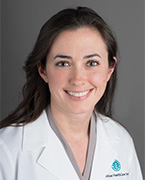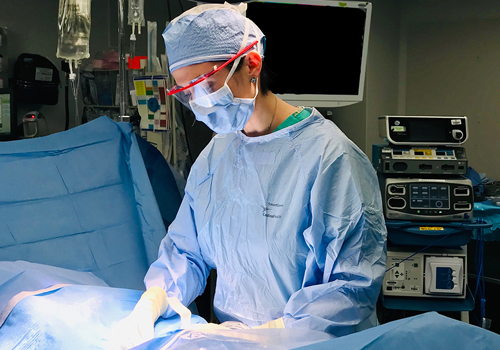Uncovering How Virtual Post-Op Visits Compare to In-Person Care
By Caroline Reinke, MD, and Kristen Harkey, NP


When we noticed more patients complaining that post-operative appointments interrupt their daily lives, we thought virtual visits could be an effective alternative, but we wanted to know for sure. That’s why we launched the first noninferiority randomized controlled trial of virtual post-op visits for patients undergoing laparoscopic cholecystectomies and laparoscopic appendectomies.
Our study has enrolled more than 350 patients, and we’re gaining key insights about delivering virtual post-op care, and about its potential to improve compliance.
How Virtual Post-Op Care Works

Outside of the study, approximately 20 to 25 % of our patients skip in-person post-op appointments, and it’s easy to see why. They have to take time off work, line up care for kids or family members, travel to a clinic and navigate the intake process. It can take a big chunk of their day just to see a physician for a few minutes.
Our study investigates a virtual visit platform that could be far more convenient. Participants can schedule virtual appointments ahead of time and download the app on their phone needed to complete a secure virtual visit. Visits can also be done on a computer without the need for an app. For the appointment, we recommend they’re in a private place where they’re comfortable showing us their incision and talking about sensitive issues such as constipation.
We use the visit to go over things like lifting restrictions, review the patient’s pathology and answer questions. If other healthcare maintenance issues are due – such a colonoscopy or mammography – we can educate and make referrals for those as well. The entire process takes approximately eight to 25 minutes, compared to 20 to 90 minutes – plus travel time – for in-person appointments.
Many Patients Prefer Virtual Visits
Our study aims to enroll 752 participants and was designed with key support from Atrium Health’s Center for Outcomes and Research Evaluation. The primary outcome is a 30-day composite measure that captures how likely virtual post-op patients are to end up in the emergency department or hospital within 30 days of surgery, compared to in-person post-op patients.
Most potential participants have been excited about a virtual alternative. This is particularly true of younger patients who are already comfortable with apps like FaceTime (although we have enrolled older patients who say “no problem, my grandkids can help me with the app!”). One notable exception has been patients having their first healthcare encounter – they can be nervous about post-discharge treatment and reluctant to receive care online.
Lessons About Providing Virtual Post-Op Care

The study has helped us learn things like how to maintain a personal connection during virtual visits. For example, we’ve learned to look directly into the camera to maintain eye contact with patients, versus looking at their eyes on the screen. And we tell patients what we’re doing when we look away from them to type out notes, so they know we’re not distracted.
We’ve also learned strategies for assessing patients virtually. In this setting, providers are not able to use all of the traditional assessment tools, primarily physical touch. Yet we can learn a lot about a patient’s comfort from how easily they’re able to move and their response to palpating their own incisions as they show them to the video screen.
Expanding the Boundaries of Virtual Care
As we evaluate our initial data, we’re particularly excited about the implications of uncovering whether virtual visits are truly noninferior. Health systems are rushing to adopt virtual care, but there is scant evidence in the surgical population regarding its effectiveness – most evaluations have relied on small-scale patient satisfaction and convenience surveys.
If our study proves noninferiority, it could open the door to expanding post-op visits to patients undergoing many types of surgery. It could also persuade payers to reimburse for virtual visits in other settings at comparable rates to in-person visits. That would make it far easier for patients to get the surgical care they need, without a clinic visit that upends their routines.
To learn more about our study, please contact Kristen Harkey at Kristen.Harkey@AtriumHealth.org or Dr. Caroline Reinke at Caroline.Reinke@AtriumHealth.org.
